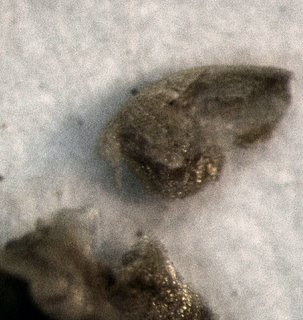Sedge Buster Lesson 5 (pictures are of Carex leavenworthii)
All righty then all ye sedge busters. It don't matter if yer sheath is baggy, if yer......
Whoa! We don't want to go there Ray. That's a particularly naughty song!
It aint no naughtier than puttin' yer hand down a fatty's spandex.
Er. That reference was metaphorical Ray, metaphorical.
Well, so's mine.
All righty then. Let's just not go there, Ray. This may be a family venue, maybe.
Well all righty then, Crumby. Aint ye touchy. Jeez Louise!
 Er. All righty then. The first picture here abouts is of the needle test on the sheath of this particular sedge. Ye can easily see that I busted the hyaline (means almost transparent and tissue like) top of the sheath, auricle) when I stuck the needle under it. It was fairly tight around the stem. Danger Will Robinson! Any key character that emphasizes vegetative vs. reproductive parts is likely to be no account. So we don't really trust this one, but we showed it here anyway cause its in all the sedge keys.
Er. All righty then. The first picture here abouts is of the needle test on the sheath of this particular sedge. Ye can easily see that I busted the hyaline (means almost transparent and tissue like) top of the sheath, auricle) when I stuck the needle under it. It was fairly tight around the stem. Danger Will Robinson! Any key character that emphasizes vegetative vs. reproductive parts is likely to be no account. So we don't really trust this one, but we showed it here anyway cause its in all the sedge keys.
 Now we get to the spongy part. Here are three C. leavenworthii achenes. Note that they are all a little less than 3mm, have toothed peryginial beaks and one of them has a hole poked in the base to show its spongy.
Now we get to the spongy part. Here are three C. leavenworthii achenes. Note that they are all a little less than 3mm, have toothed peryginial beaks and one of them has a hole poked in the base to show its spongy.
 Last we see here somewhere a closeup of the busted up base that shows just how spongy.
Last we see here somewhere a closeup of the busted up base that shows just how spongy.
Lesson 6 will be Carex perdentata which is very closely related to Carex leavenworthii. Stanley Jones figured out C. perdentata was a species, not long ago.
Whoa! We don't want to go there Ray. That's a particularly naughty song!
It aint no naughtier than puttin' yer hand down a fatty's spandex.
Er. That reference was metaphorical Ray, metaphorical.
Well, so's mine.
All righty then. Let's just not go there, Ray. This may be a family venue, maybe.
Well all righty then, Crumby. Aint ye touchy. Jeez Louise!
 Er. All righty then. The first picture here abouts is of the needle test on the sheath of this particular sedge. Ye can easily see that I busted the hyaline (means almost transparent and tissue like) top of the sheath, auricle) when I stuck the needle under it. It was fairly tight around the stem. Danger Will Robinson! Any key character that emphasizes vegetative vs. reproductive parts is likely to be no account. So we don't really trust this one, but we showed it here anyway cause its in all the sedge keys.
Er. All righty then. The first picture here abouts is of the needle test on the sheath of this particular sedge. Ye can easily see that I busted the hyaline (means almost transparent and tissue like) top of the sheath, auricle) when I stuck the needle under it. It was fairly tight around the stem. Danger Will Robinson! Any key character that emphasizes vegetative vs. reproductive parts is likely to be no account. So we don't really trust this one, but we showed it here anyway cause its in all the sedge keys.  Now we get to the spongy part. Here are three C. leavenworthii achenes. Note that they are all a little less than 3mm, have toothed peryginial beaks and one of them has a hole poked in the base to show its spongy.
Now we get to the spongy part. Here are three C. leavenworthii achenes. Note that they are all a little less than 3mm, have toothed peryginial beaks and one of them has a hole poked in the base to show its spongy.  Last we see here somewhere a closeup of the busted up base that shows just how spongy.
Last we see here somewhere a closeup of the busted up base that shows just how spongy.Lesson 6 will be Carex perdentata which is very closely related to Carex leavenworthii. Stanley Jones figured out C. perdentata was a species, not long ago.

0 Comments:
Post a Comment
<< Home